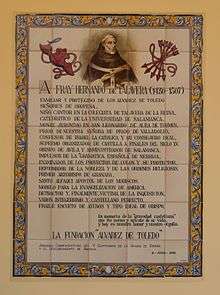Hernando de Talavera
Hernando de Talavera (Talavera de la Reina, Spain, 1428 – Granada, Spain, 14 May 1507) was a Spanish monk of the Order of Saint Jerome, of converso origins, who became Archbishop of Granada and confessor of Queen Isabela.

Hernando de Talavera | |
|---|---|
| Archbishop of Granada | |
Juan de Valdés Leal: Fray Hernando de Talavera, Museo de Bellas Artes de Sevilla | |
| Church | Catholic Church |
| Archdiocese | Archdiocese of Granada |
| In office | 1492–1500 |
| Predecessor | Newly established |
| Successor | Francisco Jiménez de Cisneros |
| Personal details | |
| Born | 1428 Talavera de la Reina, Spain |
| Died | 14 May 1507 (age 79) Granada, Spain |
| Nationality | Spanish |
| Previous post | Bishop of Ávila (1485–1492) |
| Sainthood | |
| Venerated in | Roman Catholic Church |
| Title as Saint | Servant of God |
Early life
Around 1458, Hernando graduated in Theology from Salamanca University with a degree in Theology, becoming a Prior of the Monastery of Prado near Valladolid and Royal Confessor of the ruling Queen Isabel I of Castile (1474–1504). Hernando de Talavera was also Financial Administrator of the Salamanca Bishopric (1483–1485), the Bishop of Ávila (1485–1493), and Archbishop of Granada (1492–1507), which was established after the conquest of the Moorish Emirate of Granada.
Hernando's ancestry is not known with certainty, although that is not unusual in a period in which the sanctions on descendants of Jews were severe, and fraudulent documentation ("proving" no Jewish ancestry) was common.[1] According to the accusations made against him to the Spanish Inquisition, when he was Archbishop of Granada, Hernando de Talavera was the son of the Lord of Oropesa (Toledo), related to the Great Master of the Military Order of Santiago and the bastard son of a Jewish mother, fathered by King Alfonso XI of Castile.
Hernando may also have been the son of Don García, Lord of Talavera de la Reina, born around 1370 who died in 1429 with Royal Hebrew blood. Hernando may instead have been the son of Don Fernando, born around 1390, who would have had a relationship with a Hebrew woman from Oropesa, near Talavera de la Reina, and who would have been promoted to 1st Count of Oropesa after 1475 by Queen Isabel.
Archbishop of Granada
In newly conquered Granada, the population was Muslim; their right to practice their religion was guaranteed by the conditions of Granada's surrender. Hernando's goal was to convert these Muslims to Christianity (Catholicism) peacefully, by explaining to them, in their own language as few knew Castilian, the nature of the Christian religion and its superiority over Islam. To facilitate this he promoted the study of Arabic, a language he learned himself. To him we owe the first grammar of Arabic in Spanish and the first bilingual Spanish-Arabic-Spanish dictionary, the first printed books in which Arabic letters were used; these were authored by Hernando's own confessor, Pedro de Alcalá. He did not allow the Inquisition to operate in Granada. He was very popular among the Granadine Muslims, but conversions to Christianity were few. He was replaced as Archbishop of Granada in 1499/1500 (the exact date is unknown) by the intolerant Francisco Jiménez de Cisneros, who had replaced Hernando as Queen Isabel's confessor. For Cisneros, Hernando's program of Christian instruction for the Moors was "giving pearls to pigs", and it was abandoned.[2] Armed conflict between the Moors and the Christian conquerors soon appeared, giving Cisneros occasion to prohibit the practice of Islam, in contradiction to the conditions of the city's surrender. This began the process that would lead in 1566 to the prohibition of Arabic and of Muslim clothing, the Alpujarras Civil War of 1568–1571, followed by the internal exile and finally expulsion in 1609–1610 of the Christians descended from Muslims.
Actions of the Inquisition
After the death of his protector Queen Isabel in 1504, he was denounced by the Inquisitor Diego Rodríguez de Lucero for heresy and apostasy, more specifically his opposition to the Inquisition itself (which antedated his appointment as Archbishop). Friends and members of his family were arrested. He was defended by Pope Julius II, and Cisneros freed all those arrested in 1507, the year in which Hernando died.
References
- Sicroff, Albert A. (2010). Los estatutos de limpieza de sangre : controversias entre los siglos XV y XVII. Translated by Armiño, Mauro. Newark, Delaware: Juan de la Cuesta. ISBN 1588711773.
- Eisenberg, Daniel (1992). "Cisneros y la quema de los manuscritos granadinos". Journal of Hispanic Philology. 16 (2). pp. 107–124.
Read more
- Fernández de Madrid, A ; Martínez Medina, Fco J. ; Olmedo, Félix G. "Vida de Fray Fernando de Talavera: primer Arzobispo de Granada". [Granada]: Universidad de Granada, 1992
- Fradejas Lebrero, J. “Bibliografía crítica de fray Hernando de Talavera”. En: Pensamiento medieval Hispano: homenaje a Horacio Santiago-Otero / coord. por Jose María Soto Rábanos, v. 2, 1998, pp. 1347–1358.
- Herrero del Collado, T. “El proceso inquisitorial por delito de herejía contra Hernando de Talavera”. En: Anuario de historia del derecho español, núm. 39, 1969, pp. 671–706
- Iannuzzi, I. “La biografía del reformista fray Wyn Hernando en tiempos de Carlos V”. En: Carlos V europeísmo y universalidad: [congreso internacional,Granada mayo 2000] / coord. por Francisco Sánchez-Montes González, Juan Luis Castellano Castellano, v. 5, 2001, pp. 315–328
- Kamen, Henry (2014-01-01). The Spanish Inquisition: A Historical Revision. Yale University Press. ISBN 9780300180510.
| Catholic Church titles | ||
|---|---|---|
| Preceded by Alfonso de Fonseca |
Bishop of Ávila 1485–1493 |
Succeeded by Francisco Sánchez de la Fuente |
| Preceded by Fernando de Castilla |
Archbishop of Granada 1493–1507 |
Succeeded by Antonio de Rojas Manrique |